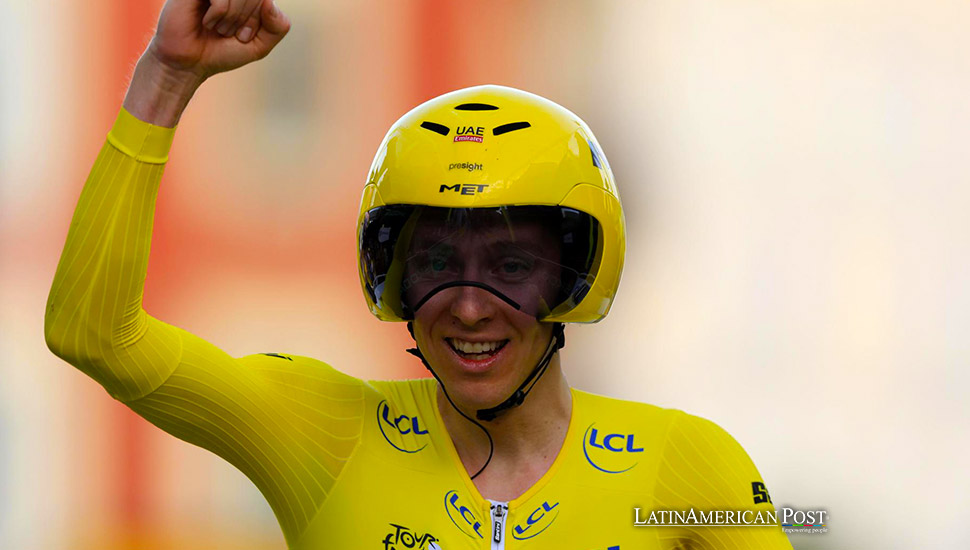Pogačar vs. Latin American Riders: Power Numbers Too Good to Believe?

Tadej Pogačar’s astonishing power numbers in the 2024 Tour de France surpass those of top Latin American cyclists. Are these performances the result of extraordinary talent, or are they suspiciously high?
In professional cycling, the numbers don’t lie—or do they? This year’s Tour de France has witnessed some of the most awe-inspiring performances in the sport’s history, particularly from Tadej Pogačar. At just 25 years old, the Slovenian superstar has not only claimed his third yellow jersey but also delivered power numbers that have left many in the cycling community in awe, especially when compared to top Latin American riders like Colombia’s Rigoberto Urán and Ecuador’s Richard Carapaz.
On July 23, 2024, Pogačar secured his sixth stage win of the Tour, dominating the final time trial in Nice. He put a substantial time gap between Jonas Vingegaard and time trial world champion Remco Evenepoel, making it his third stage win in as many days. Such performances prompt a closer look at the numbers, especially since Pogačar seemed to achieve them effortlessly and how they stack up against his Latin American counterparts.
Mastering Isola 2000
The 16.1km climb of Isola 2000 with an average gradient of 7.1% was a brutal test of endurance and power. Pogačar’s estimated average power output of 435 watts, equating to around 6.8 watts per kilogram (w/kg), over 37:37 minutes, is jaw-dropping. To put this in perspective, Derek Gee, a strong contender, finished the climb at 41:05 at 412 watts (5.8 w/kg).
Latin American riders like Rigoberto Urán, known for his climbing prowess, have delivered impressive power outputs, yet they still fall short of Pogačar’s extraordinary numbers. Urán, a podium finisher in Grand Tours, typically produces power outputs around 5.5-6 w/kg for similar efforts, demonstrating the significant gap between Pogačar and even the best Latin American climbers.
Col de la Couillole Duel
The Col de la Couillole, a 15.8km climb with a 7.3% gradient, mirrored the previous day’s challenge. Here, Pogačar and Vingegaard went head-to-head. Pogačar’s estimated average power output was 415 watts (6.5 w/kg) over 39:04 minutes. Again, Derek Gee’s power output was 412 watts (5.8 w/kg) over 41:45 minutes.
Richard Carapaz, another prominent Latin American star known for his climbing and attacking abilities, has shown great promise in Grand Tours. However, his power outputs in similar scenarios typically range around 5.5-6 w/kg. This disparity highlights how Pogačar’s numbers are exceptional and almost otherworldly compared to his Latin American counterparts.
Crushing the Time Trial in Nice
Despite having a comfortable lead, Pogačar did not hold back in the final time trial around Monaco and Nice. On La Turbie, an 8.2km climb at a 5.7% gradient, Pogačar pushed an estimated 445 watts (7 w/kg) over 16:58 minutes. On the steeper Col d’Eze, he maintained around 500 watts (7.9 w/kg) for 4:12 minutes.
These numbers are extraordinary, especially considering the physical toll of three weeks of racing. For comparison, Latin American riders like Nairo Quintana, who excel in climbing and time trials, produce impressive power outputs but generally fall in the 6-6.5 w/kg range for similar efforts. Pogačar’s ability to sustain such high power outputs after weeks of grueling competition sets him apart significantly.
Comparing Across Continents: Latin American Riders
Latin American cyclists have made significant strides in professional cycling, with riders like Urán, Carapaz, and Quintana delivering solid performances in climbing and time trials. However, even their impressive power outputs pale compared to Pogačar’s recent performances. The difference in power numbers is substantial enough to warrant skepticism and further investigation, especially when considering the historical context of Latin American cycling and the challenges they have overcome.
The comparisons become more intriguing when considering the context. Latin American riders, known for their resilience and grit, have historically faced fewer resources and less advanced training facilities than their European counterparts. Despite these hurdles, they have achieved remarkable success on the global stage. Yet, the gap in power outputs between Pogačar and these riders raises questions about the factors contributing to such disparities.
Analyzing the Data: Plausibility vs. Skepticism
Historically, cycling has seen power outputs increase with advancements in training, nutrition, and technology. However, Pogačar’s numbers push the limits of what is considered physiologically possible. Achieving and sustaining such high w/kg ratios, particularly in the third week of a Grand Tour, where fatigue is a significant factor, is rare.
Cycling has a checkered past with doping scandals, which have marred the sport’s reputation. While it is important not to cast unfounded aspersions, the dramatic jump in performance metrics demands thorough investigation and transparency. The cycling community and sports scientists must scrutinize these performances to ensure fair play and maintain the sport’s integrity, reassuring fans and professionals alike.
Impressive or Implausible?
Tadej Pogačar’s power numbers during the 2024 Tour de France are extraordinary. They highlight his exceptional talent and his strides in training and sports science. However, when performance metrics reach unprecedented levels, especially in a sport with a history of doping, it is natural to question their plausibility.
Comparisons with other top riders, including those from Latin America, underscore the magnitude of Pogačar’s achievements. His power outputs, especially during the third week of a Grand Tour, push the boundaries of human performance.
The cycling world must approach these numbers skeptically, ensuring thorough investigation and transparency. Only then can we truly celebrate the remarkable achievements of athletes like Pogačar while preserving the integrity of the sport?
Also read: Mexican Cyclist Édgar Cadena Embraces Road Racing for Freedom and Growth
Ultimately, whether these numbers are a testament to extraordinary human potential or something more sinister, they have reignited the debate over what is genuinely possible in professional cycling. As fans and followers of the sport, we owe it to ourselves to ask these tough questions and demand clear answers, ensuring we are all part of the ongoing discussion about the sport we love.




